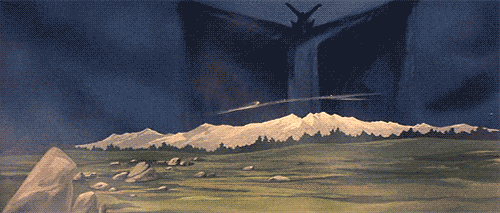
In 1964, the animators at the Toei Animation studio went on strike. This strike led to the formation of an animators' union, and the chief secretary of that union was a young animator named Hayao Miyazaki. Fast forward a year later, and one of Miyazaki's partners in the strike, an assistant director named Isao Takahata, was given the opportunity to direct his own film. Takahata wanted to adapt the puppet play The Sun Above Chikisani, but the subject of the Ainu people was considered too controversial, so he took the mythology of Japan's indigenous people and transposed it to a Scandinavian setting. Fueled by Marxist idealism, he made sure the film's production was a collaborative effort among the animators, though Miyazaki earned his own special credit due to his heavy influence over the look of the film. At a time when Toei productions were usually completed in the span of 8 months, Miyazaki and Takahata spent 3 years perfecting Horus, Prince of the Sun (Taiyou no Ouji: Horus no Daibouken). When it finally was released in 1968, it bombed but developed a cult following among college students, extremely rare for an animated film at that time. Miyazaki and Takahata, of course, would go on to found the legendary Studio Ghibli.

Watching Horus today, it's weird to think of how revolutionary the film was when it was released. Takahata was clear that he didn't want to make a children's movie like Toei's other films, but by modern day standards there's nothing about it that seems child-unfriendly. Much of the film feels like an old Disney movie, with musical numbers and cute talking animals, not what you'd expect from the director who'd go on to make such heavy, realistic films as Grave of the Fireflies and Only Yesterday. Even the scary moments are closer to Snow White than to Princess Mononoke, much less Fireflies. And while the young Miyazaki and Takahata's philosophy was far more politically radical than Disney's, the supposed "Marxist" themes in the movie are presented innocuously enough to read as a simple celebration of teamwork.

Yet in other aspects of the film, you can see the seeds of anime's budding maturity. For one thing, it's downright action-packed, throwing you right into the action at the start with a tense battle between an axe-wielding Horus (sometimes translated as Hols) and a pack of wolves (Ghibli's Tales from Earthsea directly borrowed this opening). Horus/Hols is the prototype for many a fighting shonen protagonist.

The female lead, Hilda, however, is the most interesting and revolutionary part of the film. Breaking from the black and white morality of old Disney films and Toei's older movies, Hilda is a morally grey character, the cursed sister of the demon Grunwald willing to consider dubious means to achieve her survival. Miyazaki and Takahata's future work at Studio Ghibli would be known for further complicating simplistic notions of heroes and villains, often dispensing with villains altogether. This might not make Horus the first "adult" anime as it's sometimes considered (family films like Spirited Away and The Iron Giant show that kids are more than able to handle moral complexity), but it's certainly one of the first that adults can enjoy as much as children.

Aside from a couple climactic moments interrupted by excessive freeze frames, the film's animation still looks spectacular today, the best of the old-school Disney/Toei style mixed in with the development of Miyazaki's own distinctive design sensibility. The film is licensed by Discotek in America. Anyone interested in the history of anime should check it out.
https://youtu.be/8ZX5NosrYl8
![Top 27 Best Hayao Miyazaki Anime Movies [Updated]](https://cdn.myanimelist.net/s/common/uploaded_files/1448619547-cb74c6a42c4173aadee523587151222f.jpeg)



